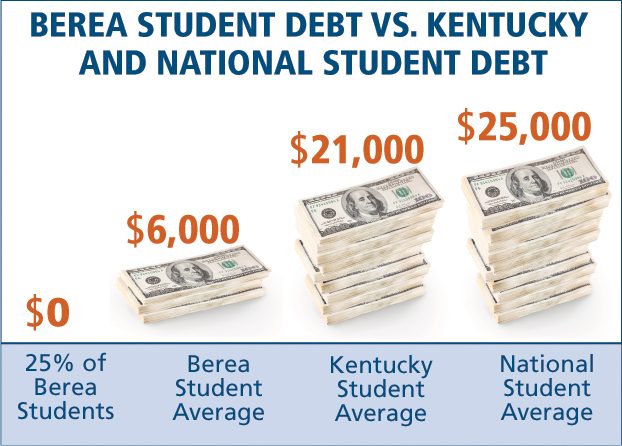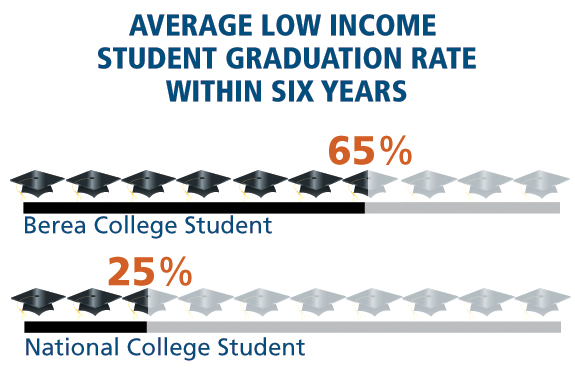Although the skilled professionals in Berea’s Office of Institutional Research and Assessment really know their stuff, even they can’t answer one question that comes up every year. The question appears on the national Common Data Set survey, through which colleges and universities share information about their admissions, academics, student life, financial aid, and other characteristics. The question reads:
If your institution has recently implemented any major financial aid policy, program, or initiative to make your institution more affordable to incoming students, such as replacing loans with grants or waiving costs for families below a certain income level, please provide details below.
That question is difficult for Berea College to answer, as there is no recent policy to expand our students’ access to a high-quality education. There is no pilot program to shrink the gap between how much college costs and how much Berea students and their families can afford to spend. There is no new initiative through which Berea defies the national trend of skyrocketing tuition and student debt.
There is only the Berea mission itself. In other words, Berea’s effort to promote accessibility, affordability, educational attainment, and equal opportunity is not at all new. It is, rather, our purest essence, the heart of the College’s identity, and so it has been since the days of John G. Fee and his fellow Berea founders.
This article will answer three related questions about what Berea College does and what makes that work possible. First, how is the Berea model built, maintained, and sustained? Second, where does the College fit into national discussions about making good education more accessible and affordable? And third, what does all of this mean for Berea students of today and tomorrow?
The Berea Fund and the Berea Endowment: A Shared Vision
As most readers of the Berea College Magazine know, Berea admits only students who come from low-income families, and all students receive full-tuition scholarships and work in campus jobs. Through this unusual approach to admissions, financial aid, and work, Berea fulfills its founding commitment to “provide an educational opportunity primarily for students from Appalachia, black and white, who have great promise and limited economic resources.”
While other schools are able to function because their students pay tuition, Berea must function despite receiving no tuition income from students. This is possible only because of alumni and friends who express their belief in the College — and the potential of our students — through generous financial support.

Markesha McCants, ’03, has a vision of ensuring that the opportunities she had at Berea will be available for future students. McCants said, “I truly feel that there is no other place in this world like Berea College. Since I have been blessed to experience all that Berea has to offer, I think it is important for me to give annually so that students with similar backgrounds can have the same opportunity.”
Individual reasons for giving surely differ, but it might be said that all Berea supporters reinforce, and become part of, a shared vision of what promising students can accomplish when they have an opportunity. In that shared vision, a gift to Berea is actually a gift through Berea to directly promote the personal, professional, and intellectual growth of deserving students who are also working hard to help themselves.
Berea’s endowment is both an outcome of that shared vision and a critical piece in sustaining it for the future. From the College’s earliest days until now, by frugally saving and investing some gifts rather than spending every dollar it receives, Berea has built a pool of financial assets known as the endowment. All bequests and other estate gifts are added to the endowment rather than being spent for current needs, a policy enacted by the College’s Board of Trustees in 1920 and still in place today.
In its history, Berea has received more than $450 million in endowment gifts from individuals and families who believed in the vision of what Berea students can accomplish with such support and wanted that outcome to be their legacy at the College. Those gifts have then been prudently invested in a diversified portfolio, generating enough income both to maintain the real value of the endowment versus inflation and to fund a substantial portion of the College’s operations — in effect, replacing tuition every year. Even after funding a large portion of Berea’s basic operations and special projects over many decades, the endowment has earned enough to increase its net value by $550 million, to a total of about $1 billion, as of June 30, 2013.
Berea’s friends and alumni also provide support through direct gifts to the College, support not put into the endowment but used annually for the various elements of Berea’s educational programs. These gifts, which are expected to total $4.15 million in 2013-14, are directed through the Berea Fund to help pay for everything from faculty salaries and classroom technology to Petri dishes for the biology laboratory and period costumes for the theatre program. Together, these gifts provide roughly 10% of the total operating budget. Endowment earnings provide more than 70% with the rest coming from students’ state and federal financial aid and other revenue sources. The Berea Fund support is essential; lacking it, we would have to reduce our overall spending by about 10%, which would require a reduction in the quality of education and the number of students we can educate.
Every Berea Fund supporter thus strengthens the impact that Berea has in students’ lives. Because our alumni and friends believe in Berea and make annual gifts, their vision of Berea’s impact is made real. With their support, the College’s academics, student support services, educational centers, professional development programs, and other elements of the learning community successfully prepare students for lives of leadership, service, and good citizenship.
The mission of Berea College must be maintained and strengthened over time. This simple but profound idea unites every type of gift, from every Berea friend and alum, and makes them all essential. The Board of Trustees’ 1920 decision to bolster the endowment was rooted in that consideration of future strength. Their prudent policy, and the mission of the College that has encouraged strong support from alumni and friends over the entire life of the institution, served to build the strength and financial soundness from which all Bereans benefit. Balancing the present and the future requires us to both manage our endowment resources prudently, avoiding exhausting that resource, while seeking regular annual gifts from our supporters.
Awareness of the future also makes reaching the Berea Fund goal an absolute necessity every year, including this year’s goal of $4.15 million. Giving to the Berea Fund represents an investment in the future even while meeting an immediate need, in that a Berea Fund gift supports a funding model that considers both the present and future success of Berea’s mission and students.

Nancy Blair, a member of the Berea College Board of Trustees and chair of the development committee, is well aware of the challenges facing Berea College as it seeks to expand the circle of philanthropy in support of its historic mission. She frames the case for support in the following way: “First, as you are able, please support us with annual gifts to the Berea Fund. These enable us to provide the excellent Berea education to 1,600 deserving students.
And, remember to support the Berea endowment, with larger gifts if your resources permit, and through bequests. If the endowment can grow faster than inflation, then we will be able to increase the number of deserving students who can receive this outstanding education.”
Berea’s Success in Fulfilling its Mission: The Evidence is Clear
Abundant evidence of the success of Berea’s mission and students is easy to find. Every issue of the Berea College Magazine is filled with moving stories of students and alumni overcoming obstacles to achieve their dreams and make a difference.

Joseph Goins, ’93, is executive vice president of WIN Learning, a thriving company that partners with local agencies and school districts to promote students’ college readiness and career preparation.
“I believe that all learners should have an opportunity for success,” Goins said, “regardless of any issues they may have in front of them. I have sought a career in education that gives me a platform to promote equal opportunity in education. Berea gave me this desire through my learning experiences and opportunities I had as a student.”
There is no greater testament to the power of Berea’s mission than Joseph and the thousands of alumni who do well in their lives and serve the greater good in their communities. Comparing the College’s outcomes to national trends in higher education provides another compelling insight into the effectiveness of Berea’s mission and programs.
To understand the soundness of the College’s funding model detailed above, consider that Forbes Magazine recently included Berea in its 2013 list of The 100 Most Financially Fit Colleges. Berea was one of only 53 institutions to receive an A+ grade. By comparison, more than half of the 925 institutions that Forbes ranked received a grade of C or below. (There is no grade inflation at Forbes!) As detailed above, the College’s strong financial health is the direct result of alumni and friends, past and present, who believe in and support the Berea mission.
To see that Berea stands alone both regionally and nationally by admitting only low-income students, charging no tuition, and maintaining higher than expected graduation rates, consider a 2011 report titled “Priced Out: How the Wrong Financial Aid Policies Hurt Low-income Students.” This report was written and released by The Education Trust, a Washington, D.C., policy organization that works to promote “high academic achievement for all students at all levels — pre-kindergarten through college,” regardless of income level, race, ethnicity, or place of origin.
The Priced Out study evaluated colleges and universities on the quality of opportunity provided to low-income students. Three measures were used: enrolling a high percentage of low-income students, ensuring that they pay a low net price for tuition and other expenses, and maintaining high graduation rates. According to the study, Berea College is one of only six institutions in the nation that effectively meet all three standards.
Of the six institutions, Berea has the highest percentage of enrolled low-income students — 85-90% of Berea students are eligible for federal Pell grants each year, and all Berea students come from families who can afford to pay very little for higher education. The College’s six-year graduation rate of 65% is also the highest among the six institutions highlighted in the Priced Out study.
In other words, according to The Education Trust, no college or university in the country can match Berea’s combination of accessibility, affordability, and quality of education for low-income students. Similarly, the Washington Monthly’s College Guide routinely ranks Berea in its Top 5 Liberal Arts Colleges in the nation, including a #1 ranking in 2011, based on similar measures of promoting social mobility and offering an excellent education.
Other data and studies show that Berea College defies several troubling national trends. First, according to Tom Mortenson, an education scholar who publishes Post-Secondary Education Opportunity, only 25% of low-income students who begin college graduate within six years. Berea’s graduation rate of 65% is thus more than double what might be expected given its student population.
Second, Berea graduates leave the College with an average debt of about $6,000, taken on to fund non-tuition expenses such as room and board and study abroad. A quarter of Berea graduates have no debt at all. This average student debt figure compares favorably with the national average of more than $25,000 and the Kentucky average of more than $21,000.
Finally, Berea provides a stark contrast to the decreasing emphasis that most colleges and universities place on need-based financial aid for less financially advantaged students. According to a 2013 study by the New America Foundation titled “Undermining Pell: How Colleges Compete for Wealthy Students and Leave the Low-Income Behind,” private colleges now focus primarily on providing merit scholarships to attract wealthy students who can pay a larger portion of tuition costs. The percentage of students receiving need-based aid at those institutions has actually decreased since the 1990s, while the percentage of students receiving merit aid has doubled.
In the same report, nearly 20% of private colleges anonymously acknowledge that they favor wealthy students with lower grades and test scores over less affluent but better-qualified students. Even more widespread is a practice known as “gapping.” Nearly two thirds of private colleges admit that they intentionally provide financial aid packages that come nowhere near meeting the needs of financially disadvantaged students, either forcing families to borrow more than they should or discouraging those students from enrolling even after being granted admission.
At Berea College, there is no “gapping.” Instead, Berea bridges the financial gap between what college costs and what families can afford. All Berea students receive need-based aid, and a student’s need is the sole determinant of the financial aid he or she receives to help pay for non-tuition expenses and fees. 
Conclusion: Success at Berea and in the Larger World
Kati Haycock is president of The Education Trust, which published the “Priced Out” study. When asked to comment on Berea’s mission and its service to students, Haycock said,
The Berea College financial aid model is both innovative and unique, and it signals the deep commitment of the college toward educating our most financially vulnerable students. Though others have adopted elements of the Berea approach, Berea puts all the pieces together: it enrolls a high percentage of Pell students and students of color while consistently having high graduation rates. And while Berea is a leader on college affordability, equally important are the student support strategies — freshmen seminars, advisors, and cultural centers — that encourage student success. These programs help create a culture of completion where graduation is the expectation not the exception.
Haycock’s insight mirrors the experiences of countless Berea alumni, including Della Justice, ’93, now a Special Assistant Attorney General in Kentucky’s Office of the Attorney General. Justice said, “I believe education is the best path for climbing out of poverty. Berea made college a reality for me, and the faculty and staff helped me see myself as a person who could succeed in the larger world.”
Such outcomes are possible only because of the endowment and the annual Berea Fund giving program, both sustained entirely by our alumni and friends. These ways to support Berea help ensure that the College’s unique combination of quality and affordability will be consistently available to students today and tomorrow.
Berea provides an affordable, high-quality, widely acclaimed education not through new programs or initiatives, but because that mission is the reason for Berea’s existence. Everything the College can offer depends on alumni and friends who support, and become part of, a shared vision of what the Berea opportunity means for our students. Gifts to Berea thus become gifts through Berea to help students work toward a promising future, become their best selves, and, as Della Justice said, succeed in the larger world.
— Alan Lowhorn worked for six years in Berea’s College Relations division as a development writer (2007-2010) and foundations/grants manager (2010-2013). Alan and his wife now live in Louisville, Kentucky, where he works as director of grants at a local nonprofit organization.


